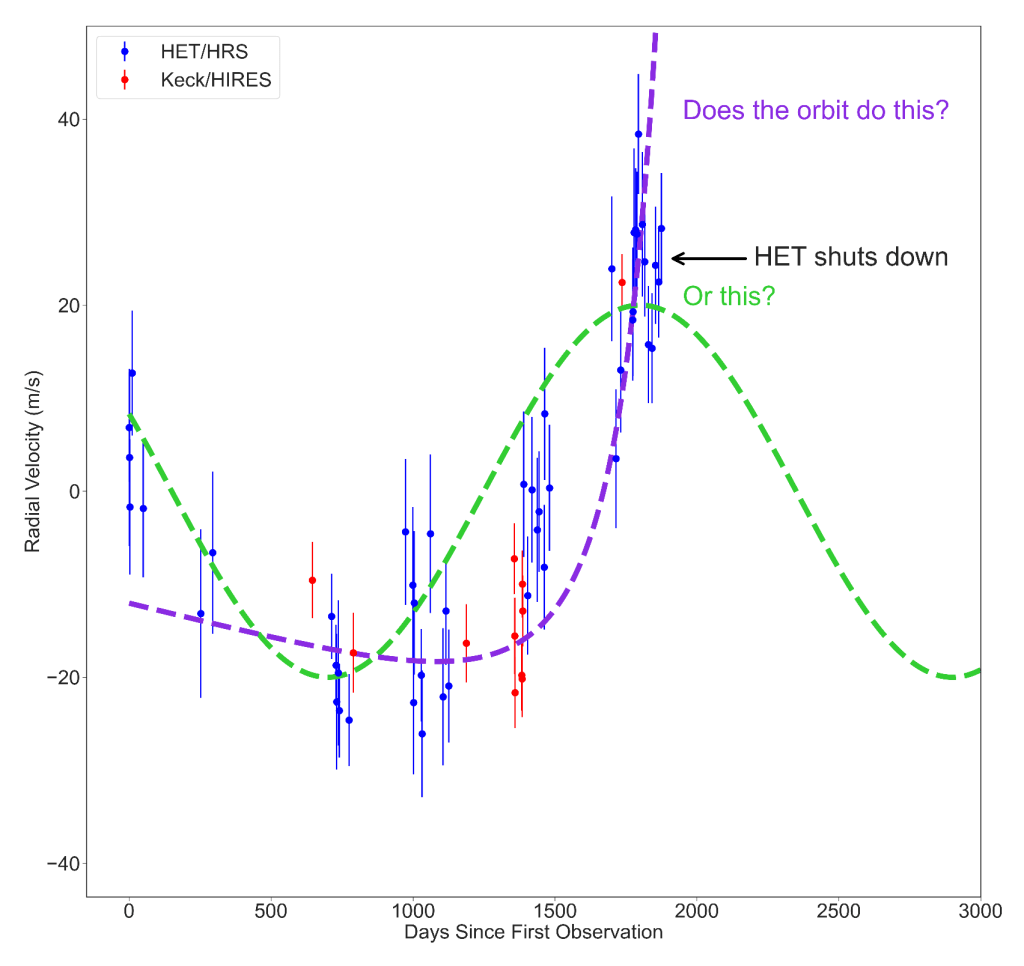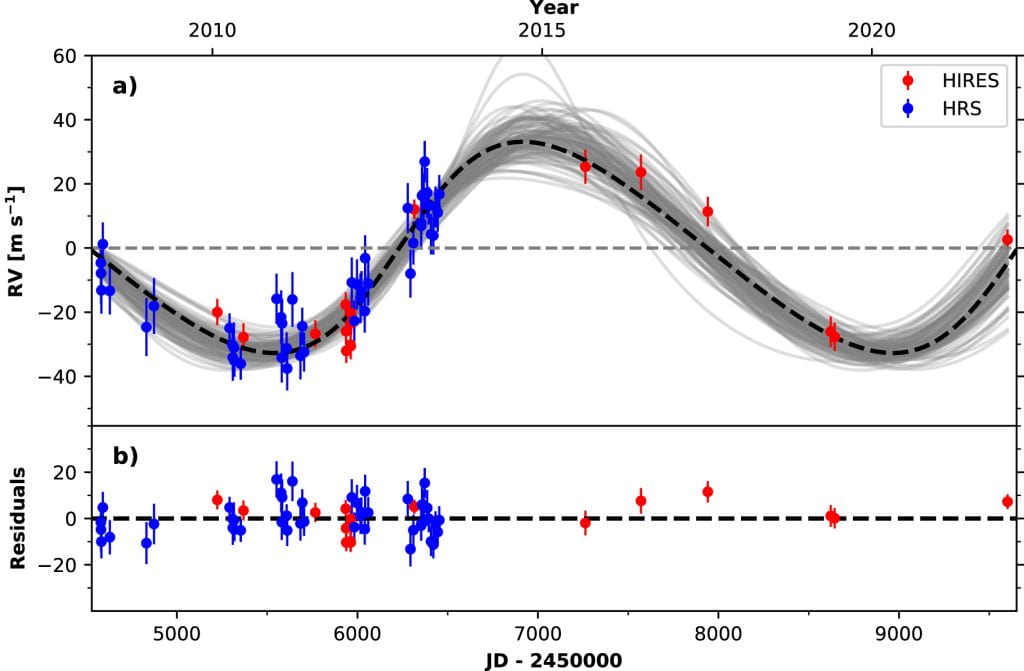Introduction: the HET/HRS M dwarf Survey
HPF is the latest and greatest in Doppler searches for exoplanets orbiting the Galaxy’s smallest stars, but it is certainly not the first, even at Texas’ McDonald Observatory. Before HPF came on sky, astronomers at McDonald Observatory–led by HPF Team members Michael Endl, Bill Cochran, Phillip MacQueen, and Paul Robertson–carried out an M dwarf exoplanet survey using the High Resolution Spectrometer, or HRS. Like HPF, HRS was installed on the 10-meter Hobby-Eberly Telescope. HRS was not a purpose-built planet hunting machine, and thus lacked a lot of HPF’s features like near-infrared wavelength coverage, extreme environmental stabilization, or a laser frequency comb calibrator. Still, HRS could make sensitive measurements of stellar motions, and its survey of 100 M dwarfs placed important constraints on the types and numbers of exoplanets that form around these small stars.
Today, we will look at the last exoplanet discovered by the HRS M dwarf exoplanet survey. Even though the last observations from that survey took place in 2013, the planet was not confirmed and announced for nearly a decade due to its long orbital period. The planet is a gas giant orbiting an M star at a large distance from its host star. It is a fascinating precursor to the ongoing HPF survey, and adds to the insight HPF is providing into the planets orbiting these tiny stars. If you’re interested in all the technical details, check out the recent publication led by HPF Science Team member Michael Endl.
Gliese 463: The Ultimate Cliffhanger
Gliese 463 (abbreviated GJ 463) is an M star that lies about 60 light years from Earth, and is half as massive as the Sun. It is a little bigger, hotter, and bluer than the stars we target with HPF, which made it perfect for the HRS spectrometer’s optical wavelength coverage.
We watched GJ 463 with HRS for a little over 5 years. Over that time, it was clear that something was orbiting the star, but we could never pin down its orbit. The reason is that the star’s velocity never “turned around,” indicating we had observed a full orbit. Without a complete orbit, it was impossible to say whether the companion was a giant planet, or a more massive object (like a star) in a more distant orbit.

Radial velocity measurements of GJ 463 from HET/HRS (blue) and Keck/HIRES (red) at the time of the HET shutdown. Possible orbit models to these data are shown in green and purple. These candidate orbits imply radically different objects orbiting the star, so we could not make any conclusions based on these data.
Unfortunately, we were never able to finish the orbit with HRS. Before we could, the Hobby-Eberly Telescope was shut down in 2013 for two years in order to upgrade it for the HETDEX survey to better understand the mysterious dark energy that drives the accelerating expansion of the Universe. At the time of the shutdown, our data looked tantalizingly close to turning around, but we couldn’t be sure. Hence, our tentative discovery of a giant exoplanet orbiting GJ 463 was left hanging in limbo.
An Assist from Keck
Luckily, the Hobby-Eberly Telescope was not the only telescope we used to observe Gliese 463. Around the same time, we were using the HIRES spectrometer on the 10-meter Keck I Telescope on Maunakea in Hawaii to measure masses of transiting exoplanets discovered by the CoRoT satellite. When our CoRoT targets had set below the horizon, we used HIRES to observe some of our HET/HRS survey targets, including GJ 463.
Our CoRoT observing program ended around the same time as the HET shutdown, but we were able to grab the occasional glance at GJ 463 thanks to a favor from our collaborators in the California Planet Search program. Still, the orbit never definitively turned around. Clearly, we were looking at a very long-period orbit.
It was only in 2019 that we finally broke through. Members of our team were using Keck/HIRES as part of our HPF project studying very rapidly rotating M dwarfs. Again, our primary targets had set for the night, so we turned Keck back to GJ 463. This time, we found that the star had finally turned around. Our models showed that the orbiting companion is a giant planet like Jupiter, on an orbit that takes nearly 10 years to complete. This is one of the most massive planets–on one of the longest orbital periods–ever discovered for an M dwarf star!

Full HET/HRS and Keck/HIRES radial velocities for Gliese 463. Our best model to the planet orbit is shown as a dashed black line. The light gray lines show alternate possible orbits allowed by our data.
Confirmation from Space
The newly-discovered planet, dubbed GJ 463b, is a large planet on a distant orbit from its host star. This makes it an ideal candidate for detection using astrometry. Astrometry as an exoplanet detection method relies on the same gravitational physics as the radial velocity technique used by HPF. As a planet orbits its star, it tugs on it gravitationally and causes it to wobble. With the radial velocity method, we measure the radial motion of the star: that is, the star’s movement towards and away from us. Astrometry measures the other component of this motion: the wobble of the star in the plane of the sky, also known as the transverse velocity. In astronomy, we frequently refer to the transverse movement of a star as its proper motion.
When a star wobbles under the gravitational influence of its planets, its motion can be measured as radial velocity and transverse velocity. HPF and other exoplanet spectrometers measure radial velocity, while the astrometry technique measures the transverse velocity. Original: Brews ohare Vectorisation: CheChe, CC BY-SA 3.0, via Wikimedia Commons
We are entering a new golden age of exoplanet discovery using astrometry thanks to ESA’s Gaia spacecraft. Gaia is measuring the positions and proper motions of 100 billion stars in the Milky Way at an unprecedented level of precision. Data from Gaia will have the sensitivity to detect exoplanets, particularly large planets on wide orbits like GJ 463b.
When we first announced the discovery of GJ 463b, we realized that it would be a good target for Gaia. We even noticed some motion in early-release Gaia data of the star that we pointed out was most likely caused by the planet. Recently, though, another study combined our data with more observations from Gaia and confirmed the astrometric detection of GJ 463b. Detecting the planet with both radial velocity and astrometry is extremely valuable, as it allows us to determine its true mass, rather than just an upper limit. From this result, we find that GJ 463b is 3.6 times the mass of Jupiter–much bigger than any planet in our Solar system, but still small enough to definitively be a planet. Knowing the GJ 463b’s true mass makes it even more valuable for future efforts to obtain direct images of the planet. Furthermore, GJ 463 is the first M dwarf system to have a planet’s mass measured using radial velocities and Gaia astrometry! This represents a fun historical distinction.

 RSS - Posts
RSS - Posts